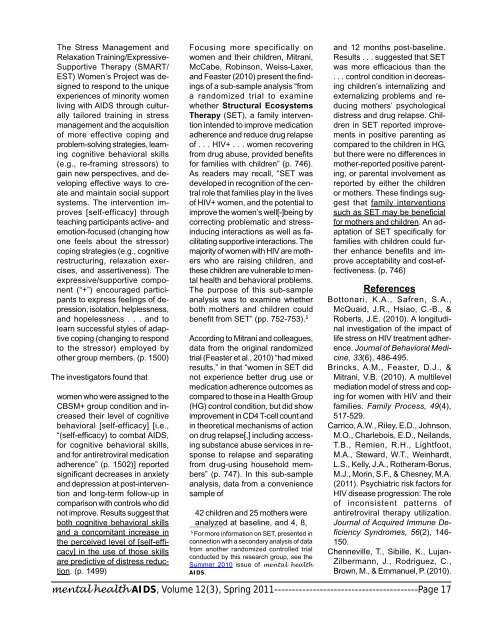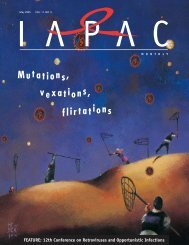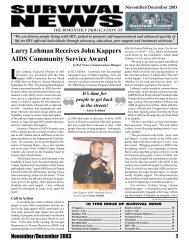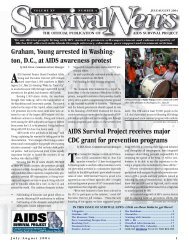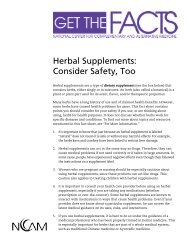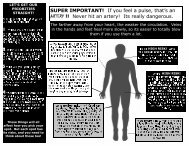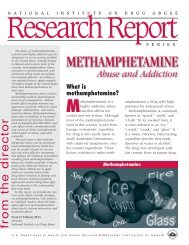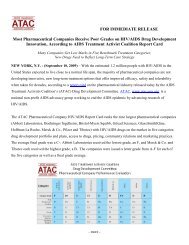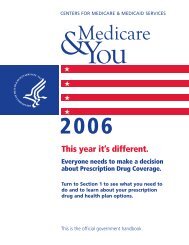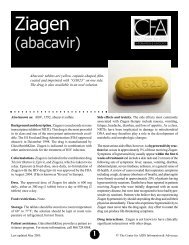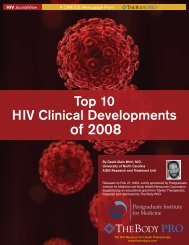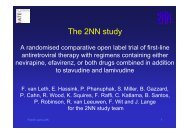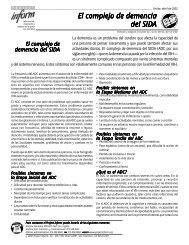Mental Health Aids. Spring 2011. - Substance Abuse and Mental ...
Mental Health Aids. Spring 2011. - Substance Abuse and Mental ...
Mental Health Aids. Spring 2011. - Substance Abuse and Mental ...
You also want an ePaper? Increase the reach of your titles
YUMPU automatically turns print PDFs into web optimized ePapers that Google loves.
The Stress Management <strong>and</strong><br />
Relaxation Training/Expressive-<br />
Supportive Therapy (SMART/<br />
EST) Women’s Project was designed<br />
to respond to the unique<br />
experiences of minority women<br />
living with AIDS through culturally<br />
tailored training in stress<br />
management <strong>and</strong> the acquisition<br />
of more effective coping <strong>and</strong><br />
problem-solving strategies, learning<br />
cognitive behavioral skills<br />
(e.g., re-framing stressors) to<br />
gain new perspectives, <strong>and</strong> developing<br />
effective ways to create<br />
<strong>and</strong> maintain social support<br />
systems. The intervention improves<br />
[self-efficacy] through<br />
teaching participants active- <strong>and</strong><br />
emotion-focused (changing how<br />
one feels about the stressor)<br />
coping strategies (e.g., cognitive<br />
restructuring, relaxation exercises,<br />
<strong>and</strong> assertiveness). The<br />
expressive/supportive component<br />
(“+”) encouraged participants<br />
to express feelings of depression,<br />
isolation, helplessness,<br />
<strong>and</strong> hopelessness . . . <strong>and</strong> to<br />
learn successful styles of adaptive<br />
coping (changing to respond<br />
to the stressor) employed by<br />
other group members. (p. 1500)<br />
The investigators found that<br />
women who were assigned to the<br />
CBSM+ group condition <strong>and</strong> increased<br />
their level of cognitive<br />
behavioral [self-efficacy] [i.e.,<br />
“(self-efficacy) to combat AIDS,<br />
for cognitive behavioral skills,<br />
<strong>and</strong> for antiretroviral medication<br />
adherence” (p. 1502)] reported<br />
significant decreases in anxiety<br />
<strong>and</strong> depression at post-intervention<br />
<strong>and</strong> long-term follow-up in<br />
comparison with controls who did<br />
not improve. Results suggest that<br />
both cognitive behavioral skills<br />
<strong>and</strong> a concomitant increase in<br />
the perceived level of [self-efficacy]<br />
in the use of those skills<br />
are predictive of distress reduction.<br />
(p. 1499)<br />
Focusing more specifically on<br />
women <strong>and</strong> their children, Mitrani,<br />
McCabe, Robinson, Weiss-Laxer,<br />
<strong>and</strong> Feaster (2010) present the findings<br />
of a sub-sample analysis “from<br />
a r<strong>and</strong>omized trial to examine<br />
whether Structural Ecosystems<br />
Therapy (SET), a family intervention<br />
intended to improve medication<br />
adherence <strong>and</strong> reduce drug relapse<br />
of . . . HIV+ . . . women recovering<br />
from drug abuse, provided benefits<br />
for families with children” (p. 746).<br />
As readers may recall, “SET was<br />
developed in recognition of the central<br />
role that families play in the lives<br />
of HIV+ women, <strong>and</strong> the potential to<br />
improve the women’s well[-]being by<br />
correcting problematic <strong>and</strong> stressinducing<br />
interactions as well as facilitating<br />
supportive interactions. The<br />
majority of women with HIV are mothers<br />
who are raising children, <strong>and</strong><br />
these children are vulnerable to mental<br />
health <strong>and</strong> behavioral problems.<br />
The purpose of this sub-sample<br />
analysis was to examine whether<br />
both mothers <strong>and</strong> children could<br />
benefit from SET” (pp. 752-753). 5<br />
According to Mitrani <strong>and</strong> colleagues,<br />
data from the original r<strong>and</strong>omized<br />
trial (Feaster et al., 2010) “had mixed<br />
results,” in that “women in SET did<br />
not experience better drug use or<br />
medication adherence outcomes as<br />
compared to those in a <strong>Health</strong> Group<br />
(HG) control condition, but did show<br />
improvement in CD4 T-cell count <strong>and</strong><br />
in theoretical mechanisms of action<br />
on drug relapse[,] including accessing<br />
substance abuse services in response<br />
to relapse <strong>and</strong> separating<br />
from drug-using household members”<br />
(p. 747). In this sub-sample<br />
analysis, data from a convenience<br />
sample of<br />
42 children <strong>and</strong> 25 mothers were<br />
analyzed at baseline, <strong>and</strong> 4, 8,<br />
5 __________<br />
For more information on SET, presented in<br />
connection with a secondary analysis of data<br />
from another r<strong>and</strong>omized controlled trial<br />
conducted by this research group, see the<br />
Summer 2010 issue of mental health<br />
AIDS.<br />
<strong>and</strong> 12 months post-baseline.<br />
Results . . . suggested that SET<br />
was more efficacious than the<br />
. . . control condition in decreasing<br />
children’s internalizing <strong>and</strong><br />
externalizing problems <strong>and</strong> reducing<br />
mothers’ psychological<br />
distress <strong>and</strong> drug relapse. Children<br />
in SET reported improvements<br />
in positive parenting as<br />
compared to the children in HG,<br />
but there were no differences in<br />
mother-reported positive parenting,<br />
or parental involvement as<br />
reported by either the children<br />
or mothers. These findings suggest<br />
that family interventions<br />
such as SET may be beneficial<br />
for mothers <strong>and</strong> children. An adaptation<br />
of SET specifically for<br />
families with children could further<br />
enhance benefits <strong>and</strong> improve<br />
acceptability <strong>and</strong> cost-effectiveness.<br />
(p. 746)<br />
References<br />
Bottonari, K.A., Safren, S.A.,<br />
McQuaid, J.R., Hsiao, C.-B., &<br />
Roberts, J.E. (2010). A longitudinal<br />
investigation of the impact of<br />
life stress on HIV treatment adherence.<br />
Journal of Behavioral Medicine,<br />
33(6), 486-495.<br />
Brincks, A.M., Feaster, D.J., &<br />
Mitrani, V.B. (2010). A multilevel<br />
mediation model of stress <strong>and</strong> coping<br />
for women with HIV <strong>and</strong> their<br />
families. Family Process, 49(4),<br />
517-529.<br />
Carrico, A.W., Riley, E.D., Johnson,<br />
M.O., Charlebois, E.D., Neil<strong>and</strong>s,<br />
T.B., Remien, R.H., Lightfoot,<br />
M.A., Steward, W.T., Weinhardt,<br />
L.S., Kelly, J.A., Rotheram-Borus,<br />
M.J., Morin, S.F., & Chesney, M.A.<br />
(2011). Psychiatric risk factors for<br />
HIV disease progression: The role<br />
of inconsistent patterns of<br />
antiretroviral therapy utilization.<br />
Journal of Acquired Immune Deficiency<br />
Syndromes, 56(2), 146-<br />
150.<br />
Chenneville, T., Sibille, K., Lujan-<br />
Zilbermann, J., Rodriguez, C.,<br />
Brown, M., & Emmanuel, P. (2010).<br />
mental health AIDS, Volume 12(3), <strong>Spring</strong> 2011-----------------------------------------Page 17


